Daytona Comparisons
The wind. The wind is blowing in the flatlands of Florida. It billows over the grandstands, spills down into the bowl and finally, stacks up against the three story high banking forming its own invisible barrier. In these conditions your air speed is thirty miles an hour higher than your ground speed. And the ground speed is intimidating. Despite the abundance and density of air, it is hard to breath because the chin bar of your helmet is smashed up against your mouth. The cheek pads of the brand new helmet have surrendered to the frontal pressure. What air you can get into your nose and mouth is pulled through a straw because the strap on your helmet is strangling you as your helmet obeys physical law and obediently tries to fill the vacuum created behind it. The track is bending away from you to the left. You are faced with a difficult decision: relieve the pressure on your throat by attempting to find shelter behind the vestigial windscreeen, or crane your neck into the windblast in order to be able to see far enough around the banking so that you have a chance to pick a clean line through the other bikes; bikes that you are closing on at 100 feet per second. You tell yourself that the speedometer is hopelessly optimistic but it is reading 170mph when your front tire slides sickly across a cold sealant patch towards a cement wall and catch fence behind which tens of Dale Earnhardt mourners gather. The bike catches traction and shakes itself straight as your mind fails to override the body’s desire to clench the bars. And you still have an entire eighth of throttle left in the grip. Disbelief as you pull the last eighth and, in what seems like an absolute defiance of all previous understanding of motorcycles, the bike positively surges ahead. Welcome to Daytona, open class style.
The Test
As every racer knows, at third call you run with what you have. You can complain about the weather, the track, the state of tune that the bike is in and the tires but you run with what you have when the green flag drops.
Sometimes comparisons of production motorcycles have similarities to real race weekends. We did not have as much time as we would have liked, we did not have the weather we would have liked but we stand ready to tell you the answer to one of the big questions of 2002: which is the best open class sport bike? The answer, in short, is it depends on what you want.
This test grew from two bikes to four bikes in the last four days preceding it. The bikes were procured in California and driven across the country to Daytona International Speedway. Learning from our past experience with the 600 test of 18 months ago (the most popular article on the Roadracing World website) we knew that time on test day would be precious in order to give each rider ample time on each bike, secure photographs and still be able to put in some un-fettered hot laps. To facilitate the testing schedule Editor David Swarts drove 3,000, unpacked the bikes, and immediately undertook fitting Michelin DOT race tires to all the bikes. Testing sport bikes on stock tires quickly becomes a test of the tires and little else.
David dutifully measured all the stock tires and the replacement Michelins to determine that we had not dramatically altered the geometry through changes in tire height. The differences were scant with the biggest change only 1mm between front and rear. These sorts of slight differences in geometry would later be rendered completely mute when we later adjusted the stock suspension to Traxxion Dynamics ideal.
Your test riders are: Melissa Berkoff (Neighbor of the Beast Endurance Rider and Roadracing World Website editor) Scott Fisher (Neighbor of the Beast rider), Jim Williams (Army Of Darkness rider) and myself. We all currently race GSXR600s.
Daytona is a very difficult track to get into, much less onto. For the riding portions of the test we shared the track with three groups of riders: Racers, Track Day enthusiasts, and Rider’s School students.
The weather was sunny but cold and very windy. The track had not had race bikes on it since it had been used for a parking lot and campground for the Daytona 500 race. Between the cold track temperatures, Daytona’s famed low frictional coefficient and the greenness of the track, traction was slim to none. We were also under the strictest possible orders that none of these motorcycles were to leave brightly colored festive markings on the pavement.
We tested the bikes in two separate configurations. We spent the morning riding the bikes with the stock suspension setting (see detail in attached sidebar). During the hour lunch break we conscripted Max McAllister into giving each bike his best seat of the pants suspension set-up. We adjusted sag (as best we could with the stock springs) and Max adjusted the damping on each bike to give what he felt would be the best performance.
Although all of the bikes felt better after his treatment, there were a few un-avoidable compromises to the handling. For instance, the R1 is fitted with soft fork springs and is set up stock with 40mm of sag. The front end would bottom over the bumps entering the fast back straight chicane. Increasing the preload in the front end improved the performance of the front end over the bumps, but also made the bike steer a little slower. With traction at a premium, none of us felt like aggressively steering any of these bikes through the tight horseshoe turns. Thus, the taller front end was better for the fast stuff, but slightly worse in the slow stuff. As the French say, such is life.
At the end of the day we all agreed that all four of the bikes could have handled better with more work. Work that would have required disassembling major suspension components, moving the forks in the trees and machining spacers. All four of the bikes exhibited the slow steering and lazy exits indicative of bikes that are too low in the rear or too high in the front. We were wishing for additional rear ride height on all of them.
None of these bikes handle as well as their 600cc counterparts. The light weights of the current open class bikes suggests that these machines would be more nimble than they actually are. If you are looking for a bike for cornering or learning to ride on the track, steer away from this quartet. The open class bikes are all more difficult to ride fast than the smaller capacity machines and are much less forgiving.
Three of these bikes have been extensively reviewed in past issues of Roadracing World. You may read the in depth technical discussion of each model online at Roadracingworld.com or in your old stacks of Roadracing World.
1. GSXR 1000 February 2001
2. CBR 954 RR March 2002
3. YZF 1000 R1 April 2002
There is a reason that the ZX-9 is absent from this list. Roadracing World was black listed from Kawasaki press launches after a former editor was implicated in the destruction of a golf cart on a press launch some years ago. Although said former editor maintains that he was framed by some resentful British, Kawasaki has declined to invite Roadracing World to its press events ever since and, hence, there is no past issue of RW that chronicles, in detail, the ZX-9.
Which really is just as well since Kawasaki doesn’t really build production road racers in the same vein that Suzuki and Yamaha do. Pointing that out in a comparison of 600s (December 2000 issue) did nothing to re-ingratiate RW with Kawasaki. The ZX-6R did not fare well in a comparison of its peers, and, rather than address the shortcomings of the ZX line, Kawasaki has tried to limit the access that Roadracing World has to review their bikes. Editor Ulrich was able to secure a ZX-9 through alternate channels for this comparison. It had 120 miles on it when it was delivered into our hands.
One of the striking aspects of these four motorcycles is that, although they all follow a similar design (aluminum framed, inline four) they actually have more technological diversity than the 600s. Three are fuel injected with Kawasaki the sole carburetor loyalist but the three FI bikes all employ different approaches in an attempt to deliver throttle response. The GSXR uses dual butterfly throttle bodies, the R! uses CV slides in the throttle bodies, the CBR employs variable inlet flaps in the air box. All three also employ various types of exhaust valves to further smooth out power but all of them differ slightly in the implementation.
All of these motorcycles would have been perfectly enjoyable by themselves. If the four of us had only had one brand (like with the factory controlled press launches) we would have happily ridden the bikes around all day at Daytona amazed by the prowess of modern machines. However, when you are able to jump from bike to bike to bike to bike in the matter of an hour on the same track with the same weather and the same tires, you quickly can sort the wheat from the chaff.
The Bikes
GSXR 1000
All of these bikes are fast and powerful. This motor stood head and shoulders above the rest. The GSXR’s defining character is its power. It has so much power. The power flows out like a giant electric motor. It is always there, waiting for you to use it. It has massive mid-range topped with an intimidating top end rush. On one lap, I left the chicane, shifted into fourth and tapped into the power. The tach revved crazily and I thought that the clutch was slipping until I backed off the gas and the rear tire regained traction. The motor has enough power to accelerate, hard, from a true 145 mph. Top speed runs were not so much about eeeking out every mile by carefully tucking in the elbows, it was about finding the fortitude to hold the throttle all the way open. You have to be really sure that you want to go where the Suzuki is pointed when you open the throttle because you are going to be there very very quickly with a wail of its raspy exhaust.
The engine highlights a few of the GSXR weaknesses dramatically. The beautiful forks do not actually work very well and the pads in the attached calipers are just barely adequate to counteract the velocities that the above mentioned engine can generate in an alarmingly short period of time.
The forks are chronically short on rebound damping. Over bumps and such it is noticeable but can be accommodated. However, at the apex of a turn, the application of even minute amounts of throttle cause the bike to accelerate aggressively. This is not in itself a problem but the forks tend to extend so fast that the bike begins to run wide out of the corner. Arriving at the next corner our test riders found themselves generally disappointed by the available brake resources. This tendency was distinctly not a problem with the fuel injection. The on/off throttle response is pretty precise (as precise as you can be when each degree of throttle turn is another 1.6 horsepower). This characteristic could also be tuned out with a fork overhaul. The brakes could be fixed with new pads.
The seating position is decidedly committed and is very comfortable on a race track. The transmission is typical Suzuki (ie, precise and low effort) and, although still better than the other bikes, is noticeably more sloppy than some of their transmissions in the past. Perhaps this is part of the big Suzuki/Kawasaki partnership. Two of us missed shifts on the new Suzuki. We agreed it was because the Suzuki transmission is so smooth that it lulls you into a false sense of security. Then, since you aren’t paying much attention, you’ll miss a gear.
Despite the GSXR’s rough edges, we were all able to modify our riding styles to accommodate the GSXR personality and, if we paid attention to what we were doing, were able to go faster than on any other bike. We all had to go through a period of adjustment when we got on the GSXR. The handling wasn’t exactly what we wanted and the motor demanded respect, once you had shifted your paradigms, it was the fastest bike on the track.
The styling, although handsome, is virtually the same as the 600 and the 750. Since they are as common as dirt, the 1000 seems somehow less glamorous than it really deserves.
R1
As was Yamaha’s intention, the 2002 R1 immediately struck everyone with its good looks. This, however, ain’t a beauty pageant.
The Yamaha does not have the sheer force of will that the GSXR motor produces but it is exceedingly well mannered. The GSXR’s power delivery seems to have more of an edge to it, as well as just having a bit more everywhere. The end result is that the R1’s power is easier to use. It had the absolute best throttle response of the bunch and, although no longer class leading, 133 odd horsepower still get you where you are going in a hurry. Certainly the R1 is capable of producing speed far in excess of the meager protection offered by its pathetic windscreen. Although its rakish devil take the hindmost look might be good on Main Street, on the banking it had us scrunching in behind the instruments looking for relief.
Yamaha has put a great deal of effort into the handling of the R1 and the effort was obvious at Daytona. With stock suspension, before and after the changes that Max made, the R1 was the best handling bike. It still felt low in the back but it steered more neutrally than all the others, it had the best front end, it could take the entrance bumps in the chicane knee down. It tracked straight and true on the banking. It was the easiest bike to hop on and go fast and, because of that, was everybody’s favorite in the morning.
Some faults. The brake pads need to be replaced with something more aggressive. The ample power would cause the front end of the bike to get very light coming out of the International Horseshoe. When the light front end hit the ripples and bumps in the pavement it would start head shaking. Suzuki learned the OEM steering damper lesson. Yamaha needs to take note now as well.
The Yamaha feels a little smaller than the Suzuki and the new for 2002 lower bars and higher pegs generated a comfortable crouch on the track.
ZX-9
Having not been impressed with the ZX-6 we did not really have high hopes for the ZX-9 but we tried to keep open minds.
The bike had some good features. Its carburetion was very good with a throttle response that rivaled the R1. The brakes were the absolute best of the bunch. It had the best wind protection so railing around on the banking was a comfortable affair. It was very stable on the banking. The handlebars are high and wide, the pegs and low and forward. This would probably be comfortable for some people in some settings but was not particularly suited to Daytona.
On the downside. The transmission was awful. It jumped out of gear for everyone. It would jump out of sixth gear just by backing off the throttle on the banking. It had false neutrals at irregular intervals in the gear box and the shifting was notchy.
The ZX-9 is about thirty pounds heavier than the other three. The weight is noticeable everywhere. It steers slower and it accelerates slower than all the rest. The front suspension felt way too soft while the rear felt much too stiff. The Kawasaki would literally jump off the track over certain bumps. Although Max addressed significant portions of the suspension’s shortcomings, it still was everyone’s least favorite bike to ride.
As with the ZX-6, the ZX-9 is just not in its element on the racetrack.
CBR 954
The Honda was the biggest surprise of the bunch. All of us expected the Honda to be quietly, unassumingly, competent. Instead we found it to be awkward, ungainly and frustrating.
The styling is either love it or hate it. We had proponents of both in our garage. The brake were not as good as the ZX-9 but better than both the Suzuki and the Yamaha. It had a very nice and precise transmission. The seating position follows Honda’s usual theory of erring towards the street but the bars felt much more narrow than the other bikes.
We were all surprised at how bad the CBR handled. In stock trim it felt vague and loose. After Max adjusted the suspension it was much better but still rivaled the Kawasaki for “worst handling”. The front end was just bad. Underdamped and undersprung, it left you wondering what was going to happen next. The rear shock would pogo over bumps. The entire bike would weave and wobble on the banking. Carving out onto the east banking (across a series of undulations in the pavement) the bike would squirm and oscillate. It gave a “cold tire” feeling even after plenty of laps. I would almost blame the behavior on the track temperatures and the pavement surface except none of the other bike were having problems in that part of the track.
And it vibrated. In the high speed runs when I was doing three laps, jumping on the next bike., doing another three laps and so on it was very obvious that the Honda had a deep vibration on the bike which made me cover the clutch with one finger while trying to concentrate on the top speed runs.
We were all surprised that the CBR had hit so wide of the mark.
The Consensus
For open class racing there is a clear and definitive winner, joining its brethren in the middle weight and heavy weight classes at the tops of podiums across the country and around the world: the GSXR 1000. If you are racing, this is the one you need. Virtually all of its shortcomings would be handily addressed in normal race preparation: rework the forks, change the brake pads, upgrade the rear shock etc. Starting with any other bike you will only be working against yourself.
But, and this is a big but, if you are not racing but want a bike for street and track days, it brings the R1 into the picture. The R1 was easier to ride fast. In the morning when the track was cold and slippery, the R1 was everyone’s favorite. In the afternoon, when we could start to use more of the GSXR’s capabilities, some of us gravitated to the GSXR. Some of us still liked the R1 more.
In stock trim the R1 handled better than all the others and had the smoothest and most user friendly power delivery. For slightly more aggressive (but not racing) riding the R1 only needs a steering damper, some brake pads, maybe a taller windscreen, and, if you felt committed, some fork springs to be a very capable street / track bike. Yamaha also seems to have addressed many of the quality issues that the R1 had early on and it looked and felt like the highest quality bike in the bunch. The fit and finish were the best, the engine was the smoothest and it handled the best right out of the box.
For the serious sport riding / track riding enthusiast we would recommend staying away from both the CBR and the ZX. Ergonomic issues on either the GSXR or the R1 (high bars, lower pegs, bigger windshields) would be far easier to rectify than the power and chassis deficits of the Honda and the Kawasaki.
The Facts
Weights with full tanks:
• Kawasaki: 472lbs
• Honda: 441lbs
• Suzuki: 445lbs
• Yamaha: 449lbs
(scales were reading a little heavy so use the weights for comparison purposes only. All bike measured with full tanks.)
Measured top speeds:
• Kawasaki: 150.2
• Honda: 151.7
• Suzuki: 157.6
• Yamaha: 151.7
Note, this is not an indication of how fast these bikes will go in an absolute sense since we had a head wind and we were measuring on a race track. It does give you an indication of the relative top speeds. We took the highest reading of six runs. Three runs with Scott on the throttle. Three runs with Sam on the throttle.
546 Horsepower, 3.56 Miles, 33 Degrees
Text By Sam Fleming
Photos By Brian J.
Credit due to David Swarts, Scott Fisher, Melissa Berkoff, Jim Williams and Michelin

Scott didn’t like the looks of this bike, but he looks good on this bike.
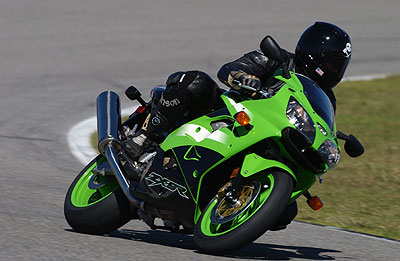
Jim is probably pulling as hard as he can on the left bar right now.

Jim looking for another straightaway.

Like a tick tattooed on a whale.
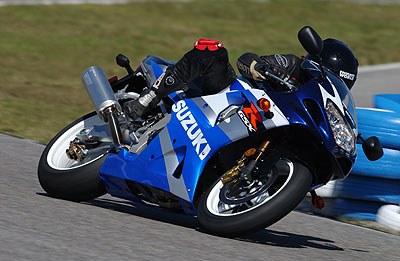
As women like to accessorize, Melissa carefully selected
an appropriate matching knee slider for the test.
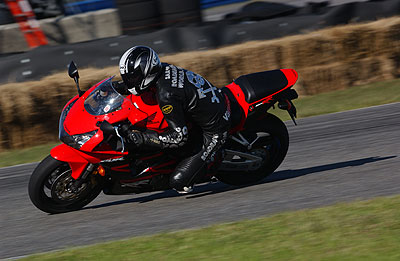
Sam did like the looks of this bike, but
he is sort of a sucker for red and black.
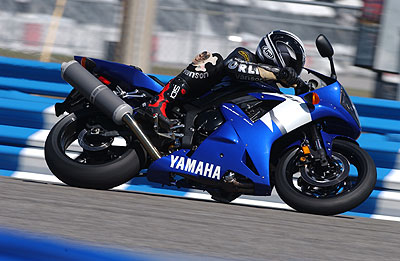
Roadracing World could not get one of the nice black
and silver R1s that would match Sam’s leather but we
did secure one that matched the Armco at Daytona.

The only bike in the lot that wanted to hold a line.

Sometimes 33° banking just isn’t enough.
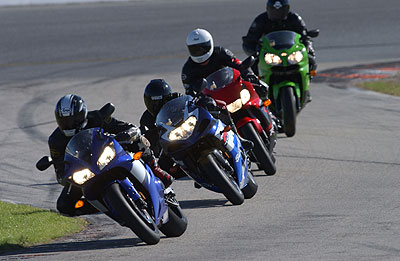
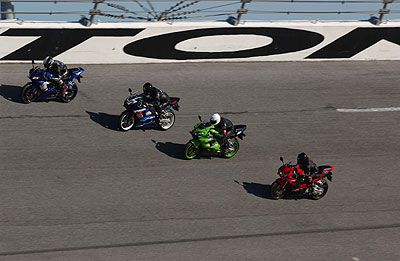
Guess which bikes are not on full throttle?
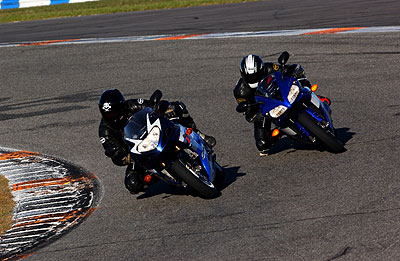
Jim protects the inside.
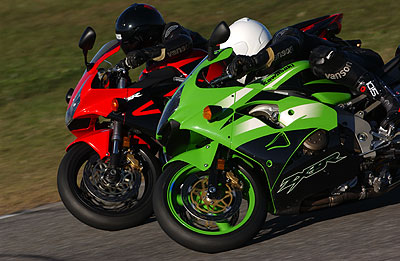
Christmas in February.

Misplaced trust that the Honda is going to maintain a trajectory.
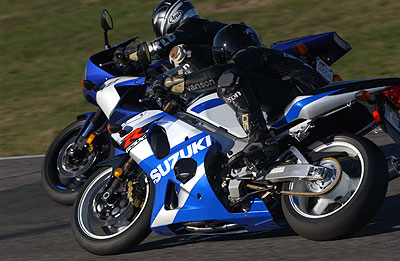
Jim and Sam wishing they could keep
these for a summer long comparison test.
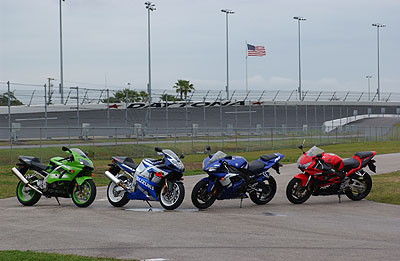
546 horsepower on the hoof.
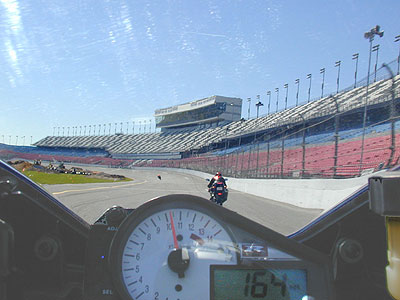
It’ll be reading 12,000 and 186 by the line.
